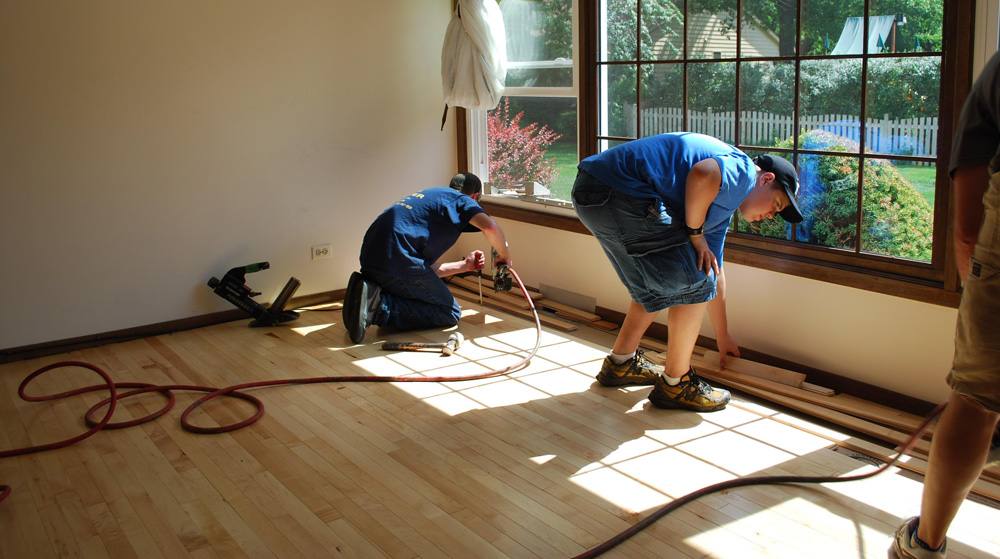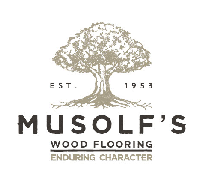
Commonly Used Hardwood Flooring Terms
Now that you have decided to install hardwood flooring, you will be speaking with a lot of folks in the industry. These terms might help you get through those conversations with a little more ease.
- Relative Humidity (RH): The amount of moisture in the air compared to the amount of moisture necessary to saturate the air. Maintaining the proper RH in your home is essential to avoid crowning, cupping and excessive gapping. An RH between 35% and 45% is best for both your health and the health of your floors.
- Hygroscopic: Refers to a substance that can absorb and retain moisture, or lose/throw off moisture. Wood and wood products are hygroscopic. They expand with absorption of moisture and their dimensions become smaller when moisture is lost or thrown off.
- Gapping: Spaces that appear between boards in dryer weather and in dryer climates. Some gapping is to be expected, especially in winter. Gapping is more likely with wider boards. To reduce the chances of gapping stay in the 3”, 4”, 5” range. Excessive gapping can result, and there is the possibility that the boards will not come back together, if moisture levels in your home are allowed to fall. We recommend that to keep your floor in the best condition possible that you humidify in the winter and de-humidify in the summer months.
- Crowning/Cupping: Wood is a living material, even after you have installed it in your home it will still respond to the environment in which it lives. Too much humidity or too little humidity can impact the wood, causing crowning or cupping.
Crowning: A convex or crowned condition or appearance of individual strips with the center of the strip higher than the edges. Generally caused by too much moisture coming from the bottom or the sub-floor. The opposite of cupping.
Cupping: A concave or dished appearance of individual strips with the edges raised above the center. Generally caused by conditions that are too dry. The opposite of crowning.
- Janka Hardness Test:The Janka hardness test measures the lb/in2 required to embed a .444-inch steel ball to half its diameter in wood. It is one of the best measures of the ability of a wood species to withstand denting and wear. It is also a good indicator of how hard or easy a species is to saw or nail. Northern Red Oak, for example, has a Janka hardness rating of 1290. Brazilian cherry, with a rating of 2350, is nearly twice as hard.
For more information see this previous blog post: https://musolfs.com/blog/explaining-the-janka-scale
- Subfloor: This is the structural layer that will support your hardwood floors. On ground floors it may be concrete or plywood; upstairs it will usually be wood. The nature of your subfloor will determine what kind of underlayment you will need.
- Underlayment: A layer of material between the subfloor and your hardwood. Depending on your subfloor and other factors, it may serve as a vapor barrier, padding, sound barrier and insulation. Underlayment may be comprised of foam, felt, cork, plastic or other synthetic materials.
- Beveled Edge: Refers to a type of edge available in hardwood flooring. With a distinct “v” shaped groove, the beveled edge is commonly used in prefinished flooring. Also used where there might be subflooring imperfections, as it helps to conceal them as well as slight differences in plank thicknesses.
Beveled flooring has grooves, as opposed to square edges that meet each board squarely. Beveled edges may allow for easier maintenance. There are several types of bevels:
Micro-beveled edges, also known as eased edges, are very slight bevels;
The traditional bevel is deeper and more pronounced;
In Musolf’s Custom Shop we can produce a micro-beveled edge as well as a hand beveled edge which produces a more rustic look.
- Plain Sawn: In Plain sawing the log is passed through the blade cutting off plank after plank without changing the orientation of the blade or log. The resulting planks have different ring orientations when viewed from the end.
- Rift Sawn: Rift sawing is a technique of cutting boards from logs. Each board is cut along a radius of the original log, so that the saw cuts at right angles to the tree’s growth ring. This produces flooring of great stability. The resulting visual is a very straight grain pattern.
- Quartersawn: Quarter-sawing gets its name from the fact that the log is first quartered lengthwise, resulting in wedges with a right angle ending at approximately the center of the original log. Each quarter is then cut separately by tipping it up on its point and sawing boards successively along the axis. Quarter sawing yields boards with straight striped grain lines, greater stability than flatsawn wood, and a distinctive ray and fleck figure.
For more information on the different cuts of wood see our most recent blog post: https://musolfs.com/blog//features-and-benefits-of-rift-and-quartered-hardwood-flooring
We hope these definitions and explanations have helped you. We love educating you on hardwood flooring so hopefully this helps you make the right decisions for your home. Obviously, we feel that hardwood flooring is great in so many ways. It does take knowledge in choosing the proper flooring, so always make sure to ask questions and express any concerns when talking with your installer or Musolf’s Crew. We are always happy to answer any questions you may have regarding wood flooring choices.
Disclaimer:
The information presented on musolfs.com is compiled from reliable sources.
That said, as a consumer, your main source of information regarding your hardwood floor should be your professional flooring installer.
Each home and installation project is unique and comes with its own set of considerations.
We are happy to present general information and tips here and hope that you find this helpful.
